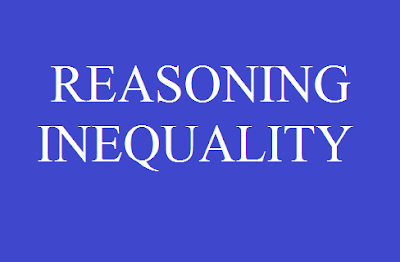We are sharing you the Short Tricks to Solve Direct and Coded Inequality Questions Instantly in IBPS, SBI, RBI and Other Bank PO and Clerk Exam. In every banking exam you may find 2-3 questions directly coming from either Coded or Directly Inequality.
Here in this Article we Under Direct and Coded Inequality Questions and Concepts in Detail, so that you can solve questions based on this topics quickly.
Here in this Article we Under Direct and Coded Inequality Questions and Concepts in Detail, so that you can solve questions based on this topics quickly.
In Exams mostly questions comes in
two forms:
1) Coded Inequality.
2) Direct Inequality.
In Coded Inequality
form, $, #, %, &, @ symbols are used. In Direct Inequality, they use direct
symbols <, >, =, ≤, and ≥ in the statement.
Meanings of Different symbols used in
the Problems:
1) < : Less than
2) ≤ : Less than or
Equal to
3) > : Greater
than
4) ≥ : Greater than or
Equal to
5) = : Equal to
Let us take we have given the following directions:
A $ B means A is not smaller than B
A @ B means A is neither smaller than nor equal to B
A # B means A is neither greater than nor equal to B
A & B means A is neither greater than nor smaller
than B
A % B means A is not greater than B
Now first you have to decode the meanings of different
symbols given- Solve it one by one:
1) First we have
Given, A is not smaller than B that means A can either be equal to A or Greater
than B i.e A ≥ B.
2) A is neither
smaller than nor equal to B that means A is Greater than B i.e A > B.
3) A is neither
greater than nor equal to B that means A is lesser than B i.e A < B.
4) A is neither
greater than nor smaller than B that means A equal to B i.e A = B.
5) A is not greater
than B that means A can either be equal to or lesser than B i.e A ≤ B.
Now form a table before solving this kind of problems:
@ : >
|
$ : >
|
& : =
|
# : <
|
% : <
|
& : =
|
Important Points to be remember while
solving Problems:
1) Symbols >, ≥,
and = should be in Ist row
110+ Blood Relation Based Puzzle Handbook PDF Download - Download
High Level Floor Based Puzzle Handbook pdf free Download - Download
300+ Reasoning Ability Speed Test Questions PDF Download - Download
200+ Important High Level Puzzle & Seating Arrangement PDF - Download
300 Important Syllogism Question with Explanation Download - Download
Alpha Numeric Series Puzzle Questions PDF Free Download - Download
Seating Arrangement Practice Set (1-35) Free Download PDF - Download
Step - 2. Login with Your Mobile Number.
Step - 3. Search @ibpsexamaspirants In the Search Box to Join Group.
Step - 4. You Can Directly Click Here to Join Group.
Step - 5 You can Discuss Your Doubts directly with Brajesh Sir.
2) Symbols <, ≤,
and = should be in 2nd row
3) ———-> Right Hand
Side Direction.
4) <———- Left Hand Side
direction.
5) In Row 1, First
Priority should go to symbol ‘>’ then to ‘≥’ & then to ‘=’.
6) In Row 2, First
Priority should go to symbol ‘<’ then to ‘≤’ & then to ‘=’.
Make Sure you make the table correct otherwise you will
loose all the 5 or 6 marks.
Let us take the following example:
1).Statements: K & B, B $ W, W # H,
H % M
Conclusions: (1) M @ W.
(2) H @ K. (3) W & K.
@ : >
|
$ : >
|
& : =
|
# : <
|
% : <
|
& : =
|
Step 1: First Make a
single statement.
K & B $ W # H % M
Step 2: Now we have to
analyze the given conclusions one by one.
1) M @ W
- If you go from M to W, you will go in a Reverse Direction i.e to the Left hand Side.
- Between M and W there are present two symbols, one is % and other is #.
- In the above table both the symbols are present in row 2 & the Highest Priority symbol is #.
- Since the direction of letters formed was to the Left Hand Side, So In Left Hand Side case we should note the symbol which is exactly above the symbol #.
- The symbol above to # is @.
- And in conclusion the symbol present between M and W is also @. So M @ W is TRUE.
2) H @ K
- If you go from H to K, you will go in a Reverse Direction i.e to the Left hand Side.
- Between H and K, the symbols present are #, $, and &.
- Check these symbols with the above table, # is in Row 2 and $ is in Row 1.Both the symbols are in different rows.
- So Conclusion 2 is FALSE.
3) W & K
- From W to K, the direction is to the Left hand side,
- Between W and K, the symbols present are $ and & and the higher priority symbol is $.
- Direction is to the Left-hand side. So we should note the symbol which is opposite to $. That is %.
- But given conclusion is W & K. So it is FALSE
Therefore Conclusion 1 alone Follows
Let us take one more example:
2) Statement: H @ T, T # F, F &
E, E % V.
Conclusions: 1) V $ F.
2) E @ T. 3) H @ V. 4) T # V
@ : >
|
$ : >
|
& : =
|
# : <
|
% : <
|
& : =
|
Modified Single Statement: H @ T # F & E % V
1) V $ F:
Left Hand Side Direction – Symbols present are % and &. Both are
in Row 2. Since the direction is Left Hand Side, and highest priority symbol is
%, we should note the symbol which is exactly opposite to % which is
symbol is $. So the Conclusion 1 is True.
2) E @ T:Left
Hand Side Direction. Symbols present are & and #. Both are in
Row 2. High priority symbol is #. Symbol opposite to # is @. So E @ T is True.
3) H @ V:Right
Hand Side Direction. Symbols present are @, #, & and % but are
in different rows. So False.
4) T # V:Right
Hand Side Direction. Symbols are #, &, and %. All are present in Row
2. High Priority symbol is #. So T # V is True. (In Right Hand Direction case
we should check for the same symbol not the opposite one)
Therefore, In this Conclusion 1, 2,
and 4 are True.
Reasoning Ability Books & Study Materials PDF
110+ Blood Relation Based Puzzle Handbook PDF Download - Download
High Level Floor Based Puzzle Handbook pdf free Download - Download
300+ Reasoning Ability Speed Test Questions PDF Download - Download
200+ Important High Level Puzzle & Seating Arrangement PDF - Download
300 Important Syllogism Question with Explanation Download - Download
Alpha Numeric Series Puzzle Questions PDF Free Download - Download
Seating Arrangement Practice Set (1-35) Free Download PDF - Download
How to Join bank4success Telegram Group for Discussion
Step - 1. Download Telegram App From Play store.
Step - 2. Login with Your Mobile Number.
Step - 3. Search @ibpsexamaspirants In the Search Box to Join Group.
Step - 4. You Can Directly Click Here to Join Group.
Step - 5 You can Discuss Your Doubts directly with Brajesh Sir.







0 Comments